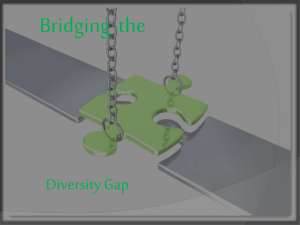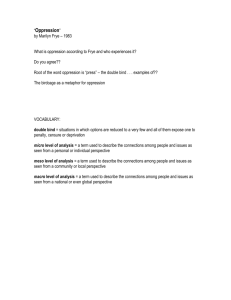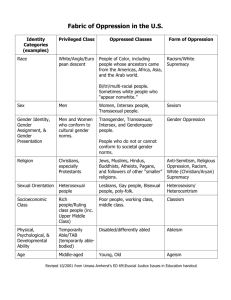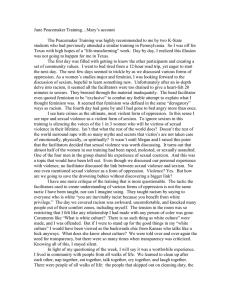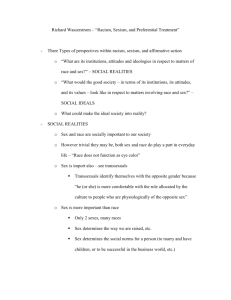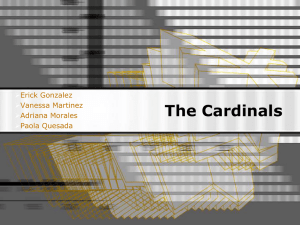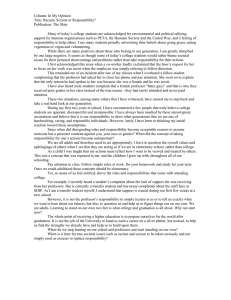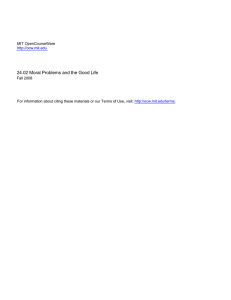Feminist Thought September 8, 2014 • Inferior along what dimension?
advertisement
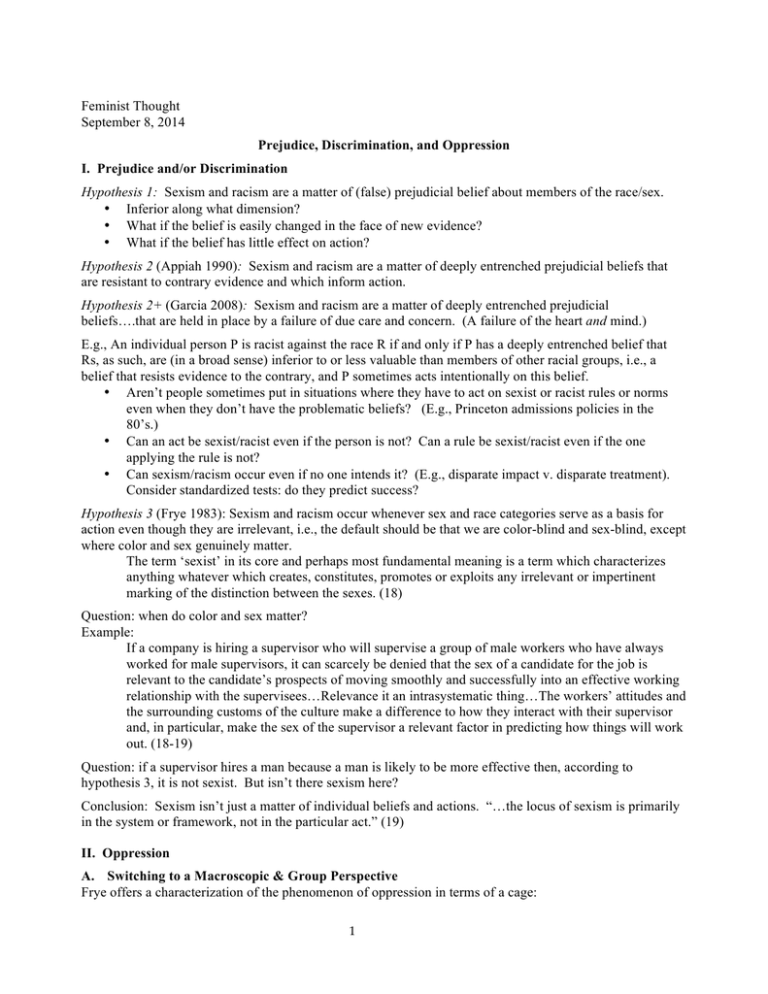
Feminist Thought September 8, 2014 Prejudice, Discrimination, and Oppression I. Prejudice and/or Discrimination Hypothesis 1: Sexism and racism are a matter of (false) prejudicial belief about members of the race/sex. • Inferior along what dimension? • What if the belief is easily changed in the face of new evidence? • What if the belief has little effect on action? Hypothesis 2 (Appiah 1990): Sexism and racism are a matter of deeply entrenched prejudicial beliefs that are resistant to contrary evidence and which inform action. Hypothesis 2+ (Garcia 2008): Sexism and racism are a matter of deeply entrenched prejudicial beliefs….that are held in place by a failure of due care and concern. (A failure of the heart and mind.) E.g., An individual person P is racist against the race R if and only if P has a deeply entrenched belief that Rs, as such, are (in a broad sense) inferior to or less valuable than members of other racial groups, i.e., a belief that resists evidence to the contrary, and P sometimes acts intentionally on this belief. • Aren’t people sometimes put in situations where they have to act on sexist or racist rules or norms even when they don’t have the problematic beliefs? (E.g., Princeton admissions policies in the 80’s.) • Can an act be sexist/racist even if the person is not? Can a rule be sexist/racist even if the one applying the rule is not? • Can sexism/racism occur even if no one intends it? (E.g., disparate impact v. disparate treatment). Consider standardized tests: do they predict success? Hypothesis 3 (Frye 1983): Sexism and racism occur whenever sex and race categories serve as a basis for action even though they are irrelevant, i.e., the default should be that we are color-blind and sex-blind, except where color and sex genuinely matter. The term ‘sexist’ in its core and perhaps most fundamental meaning is a term which characterizes anything whatever which creates, constitutes, promotes or exploits any irrelevant or impertinent marking of the distinction between the sexes. (18) Question: when do color and sex matter? Example: If a company is hiring a supervisor who will supervise a group of male workers who have always worked for male supervisors, it can scarcely be denied that the sex of a candidate for the job is relevant to the candidate’s prospects of moving smoothly and successfully into an effective working relationship with the supervisees…Relevance it an intrasystematic thing…The workers’ attitudes and the surrounding customs of the culture make a difference to how they interact with their supervisor and, in particular, make the sex of the supervisor a relevant factor in predicting how things will work out. (18-19) Question: if a supervisor hires a man because a man is likely to be more effective then, according to hypothesis 3, it is not sexist. But isn’t there sexism here? Conclusion: Sexism isn’t just a matter of individual beliefs and actions. “…the locus of sexism is primarily in the system or framework, not in the particular act.” (19) II. Oppression A. Switching to a Macroscopic & Group Perspective Frye offers a characterization of the phenomenon of oppression in terms of a cage: 1 The experience of oppressed people is that the living of one’s life is confined and shaped by forces and barrier which are not accidental or occasional and hence avoidable, but are systematically related to each other in such a way as to catch one between and among them and restrict or penalize motion in any direction. It is the experience of being caged in: all avenues, in every direction, are blocked or booby trapped. (4) Although Frye emphasizes the idea that when one is oppressed, all of one’s options are blocked and one is trapped, this is not necessarily the case. What’s at issue in oppression is that by virtue of one’s membership in a particular group one is subject to a set of structures that cause unjust subordination. The birdcage analogy is useful to see how structures rather than individuals may be to blame for one’s subordination, it is important not to be misled by the analogy. Oppression affects individuals insofar as they are members of social groups. Social groups are not just sets of individuals, but are groups whose members are marked as similar along some important dimension which is relevant to how they should be socially viewed and treated. Members of social groups will often have a shared “identity” as members of the group. B. Faces of Oppression (Young 1990 – in TF) 1. Exploitation: Exploitation occurs “…through a steady process of the transfer of the results of the labor of one social group to benefit another. The injustice of class division does not consist only in the distributive fact that some people have great wealth while most people have little. Exploitation enacts a structure relation between social groups. Social rules about what work is, who does what for whom, how work is compensated, and the social process by which the results of work are appropriated operate to enact relations of power and inequality.” (6) Examples: gender exploitation: “transfer of the fruits of material labor to men and transfer of nurturing and sexual energies to men.” (7) Racially specific exploitation: “Wherever there is racism, there is the assumption, more or less enforced, that members of the oppressed racial groups are or ought to be servants of those, or some of those, in the privileged group….” (7-8) 2. Marginalization: Marginalization occurs when “a whole category of people is expelled from useful participation in social life and thus potentially subjected to severe material deprivation and even extermination.”(9) “Marginals are people the system of labor cannot or will not use.” (8) Examples: The elderly, the poor, the disabled. The harm of marginalization is not just the material deprivation experienced, but also the fact that marginals are prevented from “[exercising] capacities in socially defined and recognized ways.” (9) 3. Powerlessness – “The powerless are those who lack authority or power even in this mediated sense, those over whom power is exercised without their exercising it; the powerless are situated so that they must take orders and rarely have the right to give them. Powerlessness also designates a position in the division of labor and the concomitant social position that allows person little opportunities to develop and exercise skills. The powerless have little or no work autonomy, exercise little creativity or judgment in their work, have no technical expertise or authority, express themselves awkwardly, especially in public or bureaucratic settings, and do not command respect.” (10) Examples: Non-professionals are powerless relative to professionals. 4. Cultural Imperialism – “To experience cultural imperialism means to experience how the dominant meanings of a society render the particular perspective of one’s own group invisible at the same time as they stereotype one’s group and mark it out as the Other.” (12) Examples: Androcentrism. Heteronormativity. Cisgenderism. Marginalization in the US of native Spanishspeakers and Latino culture. Note also ethnocentrism: 2 An attitude that one's own culture, society, or group is inherently superior to all others. Judging other cultures by your own cultural standards and since, of course, other cultures are different, they are therefore inferior. Ethnocentrism means an inability to appreciate others whose culture may include a different racial group, ethnic group, religion, morality, language, political system, economic system, etc. It also means an inability to see a common humanity and human condition facing all women and men in all cultures and societies beneath the surface variations in social and cultural traditions. FROM: http://www.webref.org/sociology/E/ethnocentrism.htm. Both individuals and institutions can be ethnocentric. 5. Systematic Violence – “What makes violence a face of oppression is less the particular acts themselves, though these are often utterly horrible, than the social context surrounding them, which makes them possible and even acceptable. What makes violence a phenomenon of social injustice, and not merely an individual moral wrong, is its systematic character, its existence as a social practice.” (13) “Violence is systemic because directed at members of groups simply because they are members of that group….The oppression of violence consists not only in direct victimization, but in the daily knowledge…that they are liable to violation solely on account of their group identity.” (13) This threat deprives people of freedom and dignity. III. Multiplicity of Oppressions (Grillo 1995 – in TF) A. Intersectionality Individuals are members of more than one social group, e.g., we are gendered and raced; we are members of an economic class; we have a sexual identity; we are disabled or able-bodied, are young, middle-aged, or elderly, attractive or not. Two aspects of intersectionality: Form of oppression: Different forms of oppression are not simply additive. It is not possible to understand sexism as a unified phenomenon that manifests itself in the same way regardless of the race or class or nationality of the individual. Sexism takes different forms depending on the other forms of oppression at play in the context. Experience: how one experiences a “face” of oppression will depend on the complexity of one’s membership in different social groups, and on the individual in question. E.g., wealthy women and poor women will experience gender oppression differently. Latinos and Latinas will experience racism differently. B. Essentialism “Essentialism is the notion that there is a single woman’s or Black person’s, or any other group’s, experience that can be described indepenently from other aspects of the person – that there is an “essence” to that experience. An essentialist outlook assumes tha the experience of being a member of the group under discussion is a stable one, one with a clear menaing, a meaning constrant through time, spae, and different historical, social, political, and personal contexts.” (32) 3 Lessons: a) Attend to multiracial and other complex categories. (33-36) b) Avoid “the oppression sweepstakes.” (36) c) “Remember who we are.” (37) Listen to those less privileged and “struggle against the tyranny we have permitted.” (37) ----------------Appiah, K. Anthony. 1990. “Racisms.” In David T. Goldberg, ed. Anatomy of Racism. Minneapolis: U. of Minnesota Press. Frye, Marilyn. 1983. The Politics of Reality. Freedom, CA: The Crossing Press. Garcia, Jorge. 1996. “The Heart of Racism.” Journal of Social Philosophy 27(1): 5-46. Frye, Marilyn. The Politics of Reality: Essays in Feminist Theory. Crossing Press, 1983. © Crossing Press. All rights reserved. This content is excluded from our Creative Commons license. For more information, see http://ocw.mit.edu/help/faq-fair-use/. Young, Iris M. "Five Faces of Oppression.” In Theorizing Feminisms: A Reader. Oxford University Press, 2005. © Oxford University Press. All rights reserved. This content is excluded from our Creative Commons license. For more information, see http://ocw.mit.edu/help/faq-fair-use/. Grillo, Trina. “Anti-Essentialism and Intersectionality: Tools to Dismantle the Master’s House.” In Theorizing Feminisms: A Reader. Oxford University Press, 2005. © Oxford University Press. All rights reserved. This content is excluded from our Creative Commons license. For more information, see http://ocw.mit.edu/help/faq-fair-use/. 3 MIT OpenCourseWare http://ocw.mit.edu WGS.301J / 17.007J / 24.237J / 17.006 Feminist Thought Fall 2014 For information about citing these materials or our Terms of Use, visit: http://ocw.mit.edu/terms.
